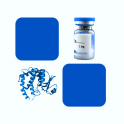
- Remove this product from my favorite's list.
- Add this product to my list of favorites.
Products
Viewed products
Newsletter
 |  |  |  |  |  |

Background
Carbonic anhydrases (CAs) are a large family of zinc metalloenzymes. CAs form a family of enzymes that catalyze the rapid interconversion of carbon dioxide and water to bicarbonate and protons (or vice versa), a reversible reaction that occurs rather slowly in the absence of a catalyst. One of the functions of the enzyme in animals is to interconvert carbon dioxide and bicarbonate to maintain acid-base balance in blood and other tissues, and to help transport carbon dioxide out of tissues. The active site of most carbonic anhydrases contains a zinc ion. They are, therefore, classified as metalloenzymes. There are at least five distinct CA families (α, β, γ, δ and ε). These families have no significant amino acid sequence similarity and in most cases are thought to be an example of convergent evolution. The α-CAs are found in humans.
Carbonic anhydrase II (CA2) is also known as Carbonate dehydratase II, Carbonic anhydrase C, is one of fourteen forms of human α carbonic anhydrases. Defects in this enzyme are associated with osteopetrosis and renal tubular acidosis. Renal carbonic anhydrase allows the reabsorption of sodium ions in the proximal tubule. Carbonic anhydrase II has been shown to interact with Band 3 and Sodium-hydrogen antiporter 1.
Source
Recombinant Human CA2, His Tag (CA2-H5228) is expressed from human 293 cells (HEK293). It contains AA Met 1 - Lys 260 (Accession # NP_000058.1).
Predicted N-terminus: Met 1
Molecular Characterization
This protein carries a polyhistidine tag at the C-terminus.
The protein has a calculated MW of 30.1 kDa. The protein migrates as 31-33 kDa under reducing (R) condition (SDS-PAGE) due to glycosylation.
Endotoxin
Less than 1.0 EU per μg by the LAL method.
Purity
>95% as determined by SDS-PAGE.
Formulation
Lyophilized from 0.22 μm filtered solution in 20 mM Tris, 150 mM NaCl, pH8.0 with trehalose as protectant.
Reconstitution
See Certificate of Analysis for details of reconstitution instruction and specific concentration.
Storage
For long term storage, the product should be stored at lyophilized state at -20°C or lower.
Please avoid repeated freeze-thaw cycles.
This product is stable after storage at:
-20°C to -70°C for 12 months in lyophilized state;
-70°C for 3 months under sterile conditions after reconstitution.
(1) "Design, synthesis and in vitro evaluation of novel thiazole-coumarin hybrids as selective and potent human carbonic anhydrase IX and XII inhibitors"
Singh, Nerella, Swain et al
Int J Biol Macromol (2024)
(2) "Discovery of a New Class of 1-(4-Sulfamoylbenzoyl)piperidine-4-carboxamides as Human Carbonic Anhydrase Inhibitors"
Moi, Vittorio, Angeli et al
ACS Med Chem Lett (2024) 15 (4), 470-477
(3) "A Dicopper(II)-Based Carbonic Anhydrase Model - Quantum-Chemical Evaluation of the Mechanistic Pathway"
Comba, Velmurugan, Baur
Angew Chem Int Ed Engl (2024)
Showing 1-3 of 4648 papers.
Follow us